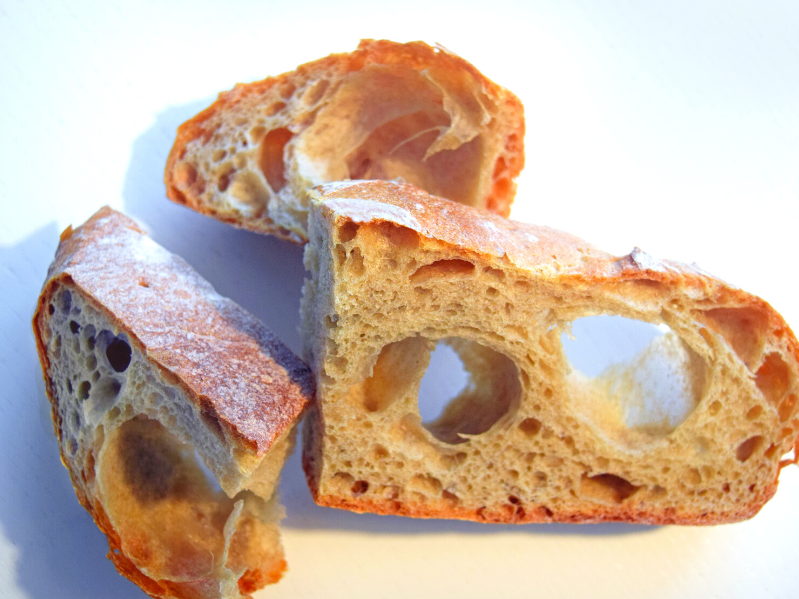Baking bread is one of my favorite things to do.
There’s something so therapeutic about the whole process, from kneading the dough to watching it rise in the oven.
But while it may seem simple, there are a few things to keep in mind if you want your bread to turn out perfectly.
One of those things is rising time.
Do you ever wonder how long is too long to let bread dough rise?
I personally have never let my bread dough rise for more than a few hours, but I’ve heard of people letting it rise for days.
So, how long is too long? And is there even a thing as ‘too long’ ?
In this blog post, we will discuss the science of bread rising and what happens when it rises for too long.
We will also provide tips on how to avoid over-risen bread. So, make sure to read on to learn more!
Can Bread Rise Too Long?
Bread can, in fact, rise for too long. When bread rises for too long, it can become over-risen. This means that the bread will turn out to be dense and dry. It will also likely have a slightly different flavor than bread that has been properly risen for the right amount of time.
Bread is kind of a tricky thing.
Get it right and you’ve got a delicious, fluffy loaf of goodness. But get it wrong and you end up with a dry, crumbly mess.
Bread dough rises because of a process called fermentation. Fermentation is when yeast breaks down sugars and produces carbon dioxide gas.
This gas makes the bread dough rise.
However, if the yeast continues to produce carbon dioxide gas for too long, the bread will become over-risen.
Bread dough should rise until it doubles in size. This usually takes between 1 and 3 hours.
Once the bread has doubled in size, it is time to shape it and bake it!
If you’re unsure or nervous about messing up your dough though (see what I did there), a great way to make sure you’ll end up with the perfect risen dough that’s ready to be popped straight into the oven is by using this perfect dough maker.
Not only can you make bread dough with it, it is also very suitable for making cinnamon rolls dough for example!
It’s programmable, has a large capacity, is easy to use and (one of the most important things if you ask me) easy to clean as well!

How Can You Avoid Over-Risen Bread?
There are a few things you can do to avoid over-risen bread.
First, make sure you use the right amount of yeast. Too much yeast will cause the bread to rise too quickly.
Second, let the dough rise in a place that’s warm, but not too hot.
Last but not least, keep an eye on the dough while it’s rising.
It is important to remember that bread dough is a living thing.
It will continue to rise even after it’s been shaped and placed in the oven.
For this reason, it’s important not to let the dough rise for too long before baking it. Otherwise, you will end up with a loaf of over-risen bread!
And trust me, nobody wants that.
How To Tell If Bread Is Over-Risen
There are a few telltale signs that your bread is over-risen. First, the bread will be very dense and dry.
Second, the flavor of the bread will be slightly different.
The flavor of over-risen bread can best be described as ‘yeasty’ or ‘alcoholic.’
And finally, the bread will have large, uneven holes and a crumbly texture.

If you notice any of these signs, it’s best to throw out the bread and start over.
Even though you may be tempted to eat it, over-risen bread is not very good!
Can You Knead Dough After Rising?
You can, but it won’t do much good.
Once the dough has risen, the gluten strands will have already formed.
Kneading the dough at this point will not make a difference in the texture or flavor of the bread.
If you need to, make sure to do so gently so as not to deflate the dough too much.
Does Bread Dough Need To Rise Twice?
Bread dough only needs to rise once. However, some people like to let it rise twice.
This is because the second rise tends to make the bread even lighter and airier.
If you do choose to let your dough rise a second time, make sure not to let it over-rise.
The best practice to rise dough twice is to let it rise the first time until it doubles in size.
Then, shape it into a loaf and let it rise a second time until it doubles in size again.
Once it has doubled in size for the second time, bake it immediately!
Why Do You Cover Dough With A Damp Cloth?
Covering dough with a damp cloth helps to keep the dough from drying out.
It also prevents the formation of a crust on the surface of the dough.
It is important to use a damp cloth and not a wet one. Otherwise, the dough will become too wet and sticky.

If you don’t happen to have a damp cloth, you can use a clean kitchen towel.
However if you’re looking for something specifically suitable for rising dough, I personally love to use these awesome cotton bowl covers.
Just make sure to not use a paper towel as it will stick to the dough.
Can Dough Rise In A Metal Bowl?
Yes, dough can rise in a metal bowl.
In fact, metal bowls are often used for rising bread dough.
However, it is important to make sure that the bowl is not too hot. Otherwise, the yeast will become too active and the bread will over-rise.
Metal bowls are good conductors of heat, so it’s especially important to make sure the bowl is at room temperature and not warmer when using one for rising dough.
You can use an instant-read thermometer to accurately check the temperature.
Can Dough Rise In A Plastic Bowl?
You can definitely rise dough in a plastic bowl.
However, just like with a metal bowl, it is important to make sure that the bowl is at room temperature (not too hot!).
When the plastic bowl is too hot, it will cause the dough to easily over-rise.
It is also important to make sure that the plastic bowl is clean. Otherwise, the bread will pick up flavors from the plastic.
Plastic bowls are less conductive than metal, so they may not warm the dough as much during rising.
However, it’s still best to be cautious and keep plastic bowls at room temperature as well to avoid unwanted flavors or overproofing.
Other Questions You May Have
How do I know if bread dough has risen too long?
If the dough is very puffy and soft or deflated, it has likely overproofed. You can also gently poke the dough – if the indentation doesn’t fill in at all, it’s overproofed. Paying close attention during the rising process will help you learn what properly proofed dough looks and feels like.
What happens if bread dough rises too long?
Overproofed dough can collapse or flatten out during baking. It may not rise properly in the oven and the texture of the bread can become dense and gummy instead of an airy crumb. The flavor can also be affected as there will be a sour taste.
Overproofed loaves are disappointing to eat compared to bread with the proper rise.
How can I prevent overproofing bread dough?
Use a thermometer to monitor the temperature of your dough as it rises – between 75-80°F is ideal. Watch for a 1-2x size increase as a guide. Refrigerate or shape dough into loaves if it nears overproofing. Careful temperature control and proofing will result in beautifully risen bread.
Is it okay to let bread dough rise overnight in the fridge?
An overnight slow rise in the fridge is a common technique for many bread recipes. The colder temperatures slows yeast activity for a better flavor with less risk of overproofing. Refrigerated dough is very convenient to work with the next day.
Can I shape pizza dough and let it rise at room temperature overnight?
It’s generally not recommended to let pizza dough or other shaped dough rise overnight at room temperature due to the higher risk of overproofing. For best results, both the first rise and the final proofing stage before baking should be closely monitored. Careful timing is needed for shaped doughs.
How long should sourdough bread dough rise at room temperature?
Since sourdough uses wild yeast cultures instead of commercial yeast, rise times can vary more. As a guide, room temperature bulk fermentation takes 4-8 hours, with final shaping proofing 1-3 hours depending on recipe and temperature of your kitchen. Natural leavening requires more observation of the specific dough.
What temperature should water be for activating yeast?
Warm water with a warm temperature between 105-115°F is best to activate yeast. Water that is too hot can deactivate the yeast, while water that is too cold will inhibit yeast activity and prolong rising times.
Properly activating the yeast by focusing on the right temperature of the water is crucial for good rise and flavor in the finished bread.
How do I know if my bread dough has risen enough before baking?
When pressed gently with a finger, the indentation should slowly fill in within a minute or so. This “poke test” indicates the dough has developed enough gluten structure and carbon dioxide bubbles for the final rise in the oven. The poke test is an easy way to check doneness without complex equipment.
What temperature is best for rising bread dough?
Most bread dough prefers a warm 75-80°F environment to rise. Warmer temperatures can cause dough to overproof more quickly, while a lower temperature (below 70°F) will slow the process down too much. Maintaining the proper rising temperature range will ensure well-risen loaves.
Can I use fresh yeast instead of active dry yeast in bread recipes?
Most recipes can be made with an equal amount of fresh yeast instead of active dry yeast. Since fresh yeast is stronger, the rise time may be faster, so it’s best to follow specific instructions for the type of yeast used. Understanding your yeast is key to baking success.
Final Thoughts
So, when it comes to rising bread dough, there is such a thing as too long!
If you let the dough rise for too long, it will become over-risen and the bread will become dense, dry, and crumbly.
To avoid this, make sure to use the right amount of yeast, let the dough rise in a warm (but not too hot) place, and keep an eye on it while it’s rising.
Once the dough has doubled in size, shape it into a loaf and bake it immediately.
And that’s all there is to it! Now you know everything there is to know about rising bread dough.
Do you have any tips for rising bread dough? I’d love to hear them! Contact me and let me know.
Enjoy your delicious, freshly-baked bread! And remember, don’t let it rise too long! 🙂
